Mentsuyu (Japanese Noodle Soup Base)
Upgrade your noodle game with homemade mentsuyu sauce. This umami-packed soup base is perfect for cold noodle dipping sauces or comforting hot noodle broth.
Mentsuyu is a versatile Japanese noodle sauce that adds a punch of umami flavour to any dish. It is sweet, savoury and deeply flavoured.
This homemade mentsuyu recipe is effortless and delicious, making it the perfect addition to your Japanese essentials pantry.
And, with a shelf life of up to four weeks, you can use concentrated mentsuyu to create easy Japanese meals in no time. Use it as a soup base for hot noodle soups or create a dipping sauce for cold noodles or tempura.
So why settle for store-bought mentsuyu when you can easily make this delicious soup base at home?
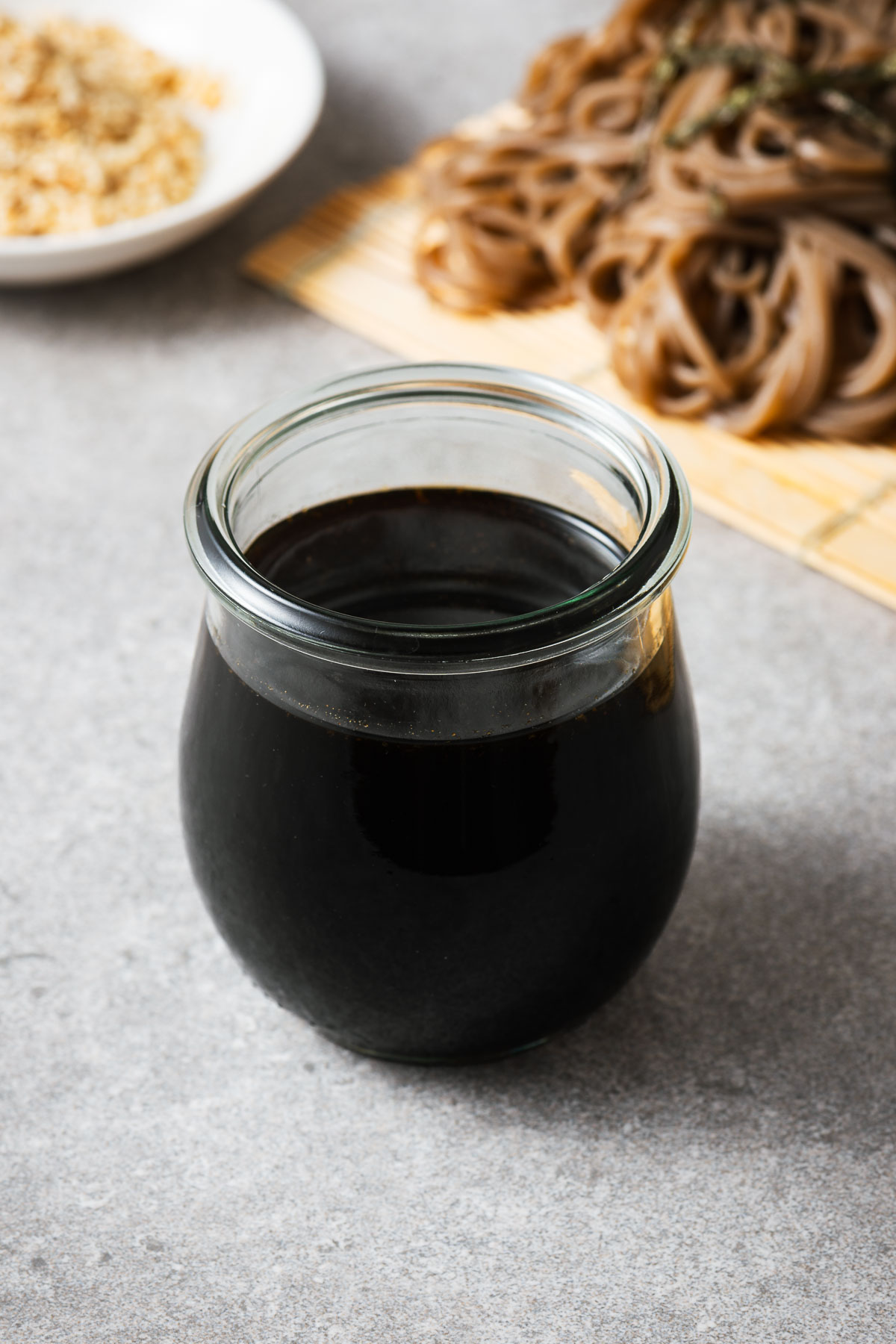
What is mentsuyu?
Mentsuyu is a stock used in many traditional Japanese dishes (like kake udon and zaru soba). It is made from awase dashi broth, a combination of bonito flakes and kombu kelp, with added ingredients such as soy sauce, sake (rice wine), and mirin (sweet rice wine).
Similarly, tentsuyu refers to tempura dipping sauce – made from scratch or using concentrated mentsuyu. And tsuyu refers to any of these Japanese stock sauces.
Mentsuyu is most commonly used as a noodle dipping sauce for cold noodles (like with soba noodles or somen noodles), as well as a warm soup base for Japanese noodles (like soba noodle soup and udon noodle soup).
Ingredients and substitutes
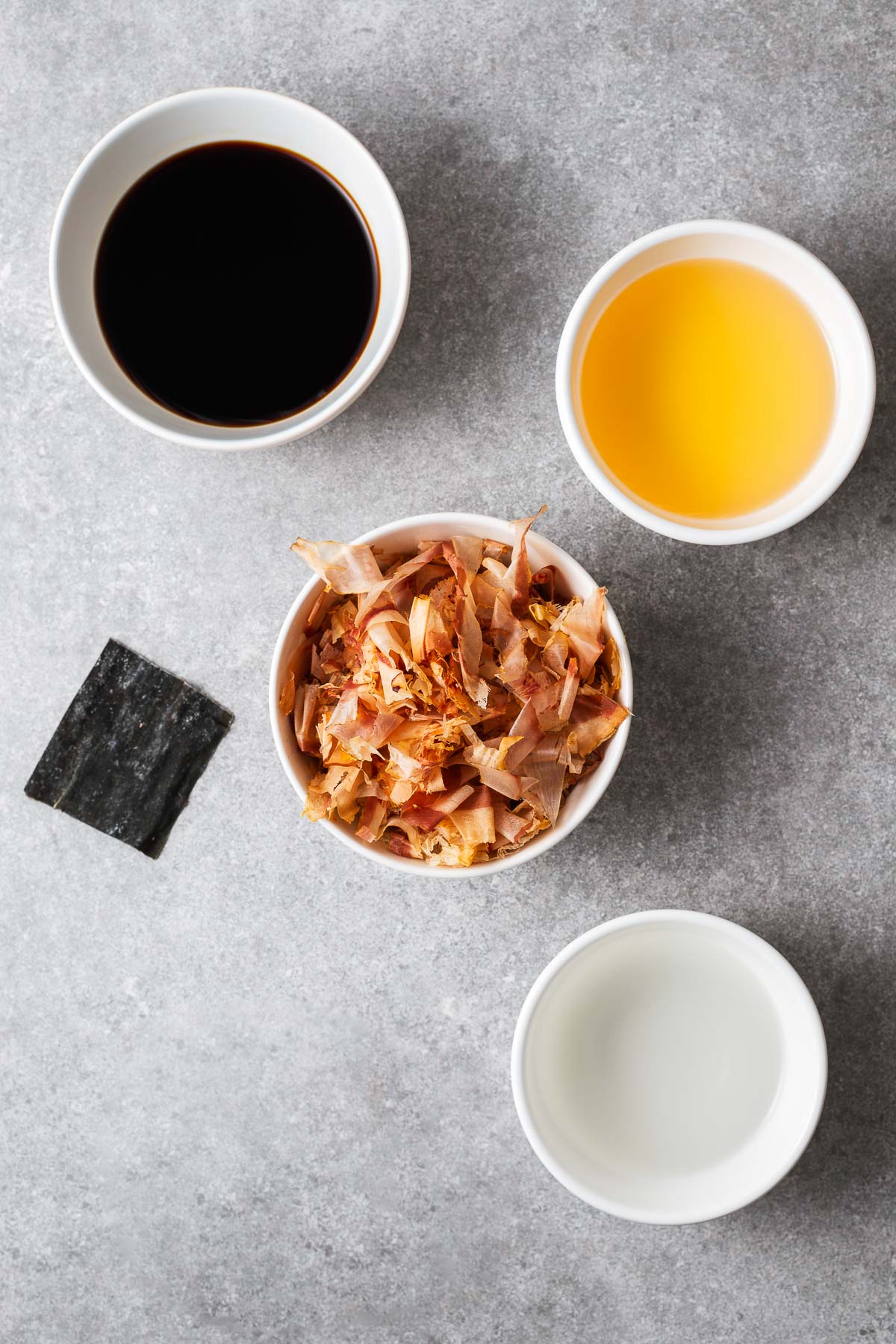
Homemade mentsuyu requires only a handful of ingredients and a few minutes to make:
- Sake: Sake adds a depth of flavour to this mentsuyu recipe. You can use cooking sake or normal sake. And if you don’t have sake, you can use Chinese rice wine or dry sherry as a substitute.
- Mirin: Mirin is a sweet rice wine that adds a subtle sweetness to this dish. If you can’t find mirin, substitute it with more sake and add sugar to taste.
- Soy sauce: Soy sauce (or shoyu) is the key ingredient that gives mentsuyu its signature umami flavour. Use any all-purpose or light soy sauce (not dark soy sauce) or try tamari for a gluten-free option.
- Kombu: Kombu kelp is a type of dried seaweed that adds a rich and savoury flavour to the mentsuyu soup base.
- Katsuobushi: Katsuobushi, or dried bonito flakes, adds a smoky and fishy flavour to this dish. If you are vegetarian or vegan, you can use rehydrated dried shiitake mushrooms as a substitute – see the recipe card for instructions.
These ingredients are readily available in Asian grocery stores.
For a quick mentsuyu: Replace the kombu and katsuobushi with a teaspoon of dashi powder. Then there is no need to simmer and strain your sauce. Simply mix everything together and you are ready to go.
You can also use dashi stock to make mentsuyu (awase dashi or kombu dashi) to replace the kombu kelp and bonito flakes, but your mentsuyu won’t be concentrated. But this is not an issue, since you always dilute concentrated mentsuyu sauce with water when using. Simply use less water!
How to make mentsuyu
First, gather your ingredients.
You will need:
- a quarter cup of sake,
- half a cup of mirin,
- half a cup of soy sauce,
- a 2-inch (5 cm) square of kombu,
- and a heaped cup of katsuobushi (dried bonito flakes).
Now you are ready to make your mentsuyu sauce in three easy steps.

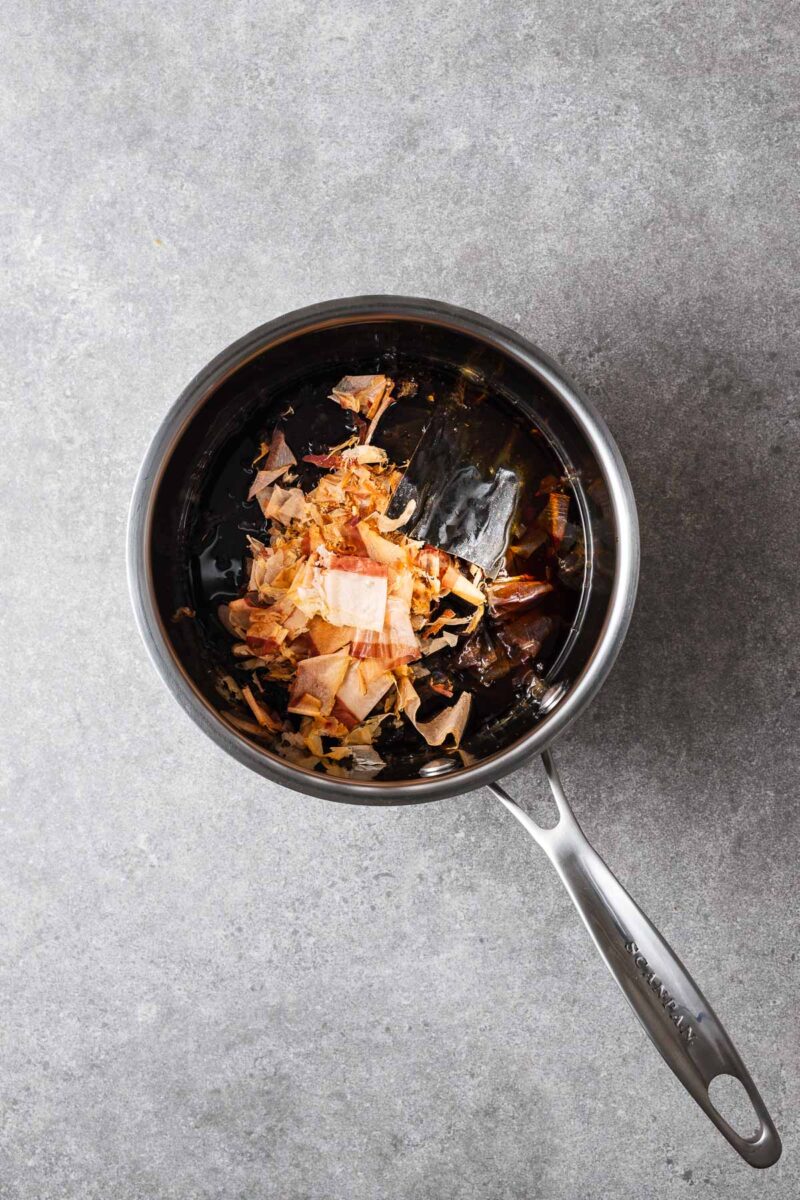
Step 1: Prepare the sauce. In a small saucepan, bring the sake to a boil over medium heat and cook for a few seconds to allow some of the alcohol to evaporate.
Step 2: Add the remaining ingredients and bring the sauce to a gentle simmer. Reduce the heat to low and let it simmer for 5 minutes.
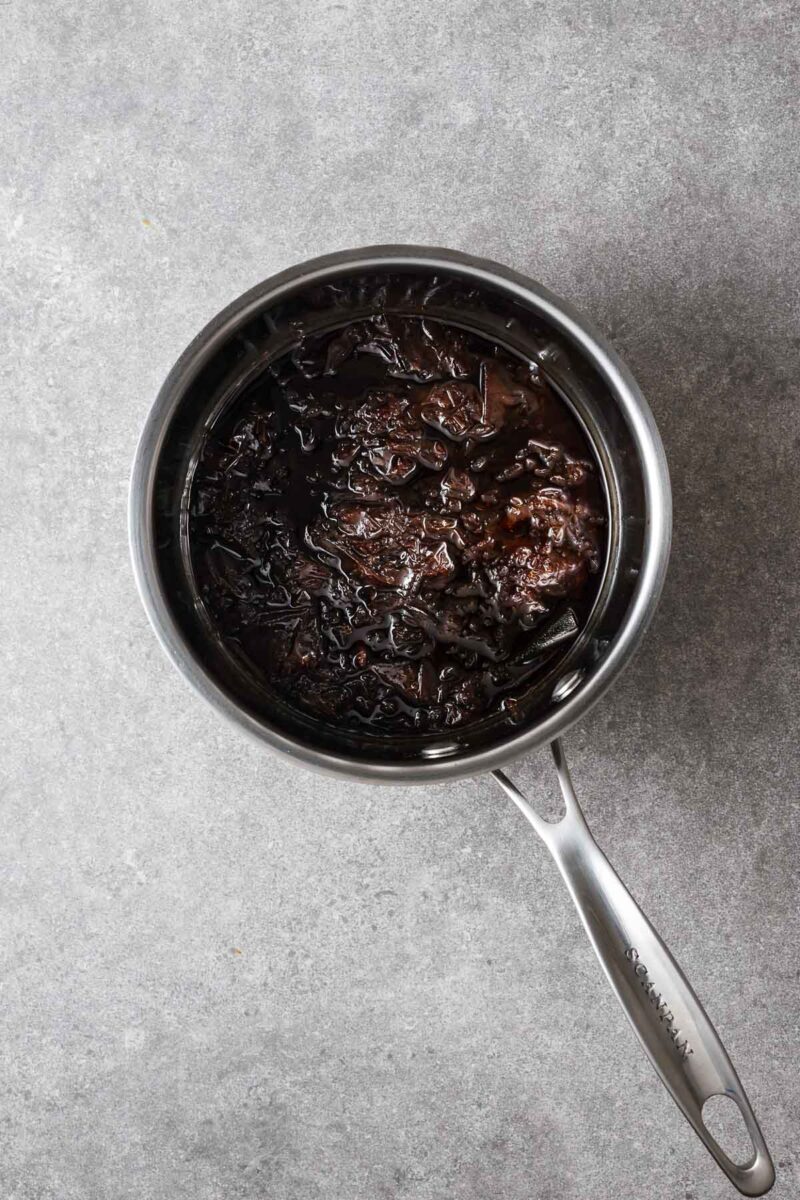

Step 3: Cool and strain the mentsuyu sauce. Remove the saucepan from the heat and let the mentsuyu sauce cool for at least 5 minutes. Then, using a fine mesh strainer, drain the liquid to remove the kombu and katsuobushi.
Don’t throw away the spent kombu and katsuobushi after straining the mentsuyu sauce. Use them to make furikake seasoning (recipe from Just One Cookbook). Or, finely chop the softened kombu and katsuobushi, mix it with a splash of toasted sesame oil and a pinch of togarashi (or chilli flakes) and use it as a flavour-packed condiment to spoon over Japanese rice and noodle dishes.
Your stock is now ready to use. Store mentsuyu in an airtight container in the refrigerator for up to 4 weeks. This recipe yields just over a cup of mentsuyu. It’s enough to make four cups of Japanese noodle broth or three cups of tsuyu dipping sauce.
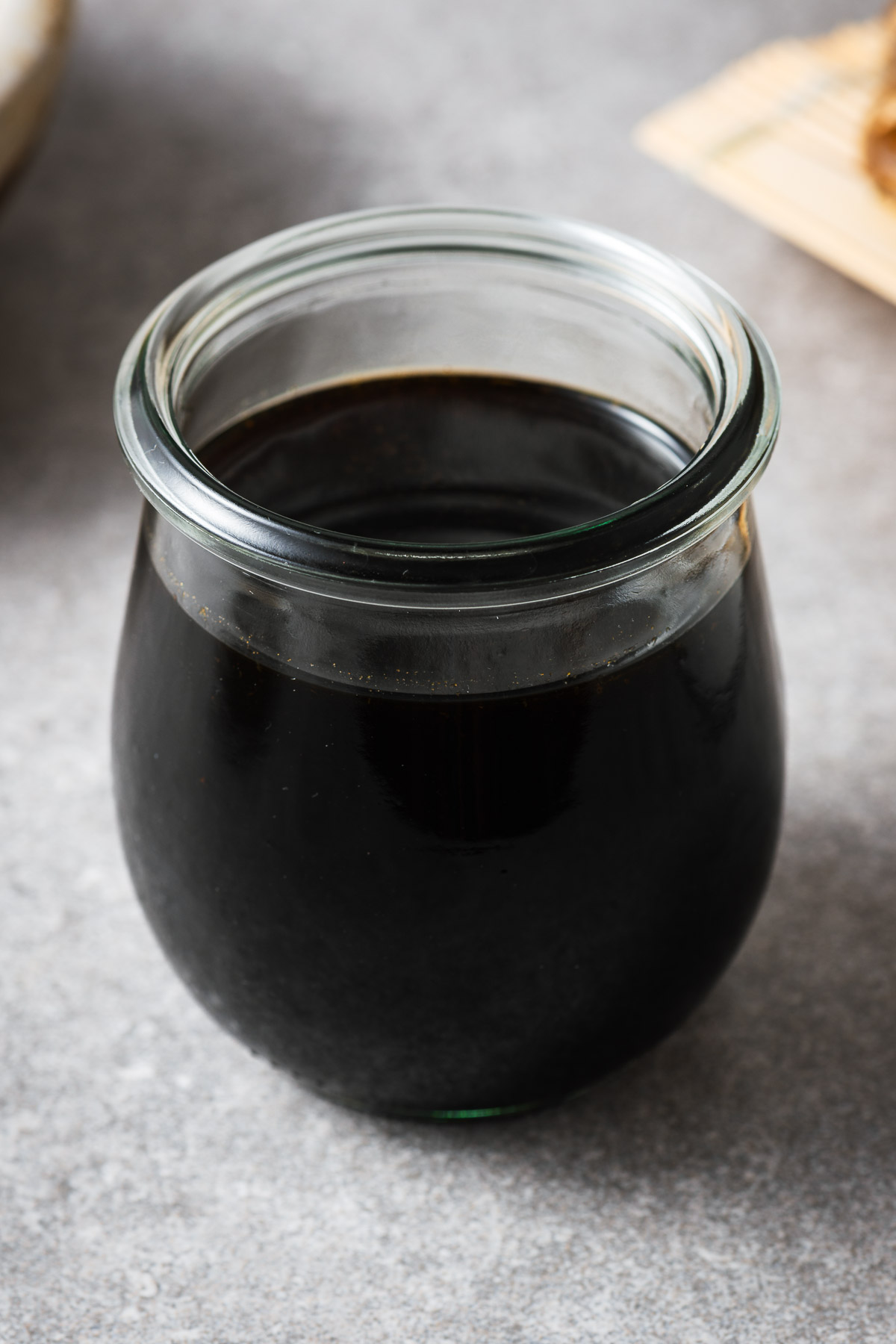
How to use mentsuyu
This recipe creates a concentrated mentsuyu sauce. In order to use it as a soup base or dipping sauce, you first need to dilute it with water.
- Mentsuyu noodle soup base: The most popular use for mentsuyu is as a noodle broth for traditional Japanese noodles such as soba noodle soup and udon noodle dishes like kake udon (udon noodle soup), tsukimi udon (udon noodle soup with egg yolk) and kitsune udon (udon noodle soup with fried tofu). Dilute one part mentsuyu with three parts water. Taste and add more water or mentsuyu to your preference. Place cooked noodles in a bowl and pour over the hot noodle broth. Top with sliced green onions (and optionally your favourite protein) for a satisfying meal.
- Cold noodle dipping sauce: Dipping cooked and cooled soba noodles in cold mentsuyu dipping sauce (called zaru soba), is just as satisfying on a warm day as hot noodle soup is on a cold one. Here I like to serve the dipping sauce cold and strong. Start with one part mentsuyu sauce to two parts ice-cold water. Taste, and adjust. See cold soba noodles with dipping sauce for the zaru soba recipe.
- Tempura dipping sauce: Mix one part mentsuyu sauce with one part water and a pinch of sugar (or more to taste) for an easy, sweet and savoury tempura dipping sauce.
- Hot pots: You can also use mentsuyu as a base for hot pots as you would sukiyaki sauce, providing a rich and flavourful broth for meats, vegetables, and noodles to cook in. Add in your favourite ingredients and let them simmer in the diluted mentsuyu broth until cooked to perfection.
- All-purpose seasoning: Try mentsuyu in your next stir-fry or use it to marinade fish and meat for an umami-packed main meal.
With this easy homemade mentsuyu recipe, you can enjoy the classic flavours of your favourite Japanese food in your own home. It is mind-blowingly delicious.
Frequently asked questions
Mentsuyu is a Japanese soup base typically made from dashi (fish and seaweed stock), soy sauce, mirin (sweet rice wine), and sugar. However, different regions and households may have their own variations of the recipe.
Tsuyu is a general term for any type of stock or soup base in Japanese cuisine, while mentsuyu specifically refers to a noodle soup base made with dashi, soy sauce, mirin, and sake. Other types of tsuyu may include different ingredients.
Mentsuyu is often used as a soup base for noodle soup dishes such as kake udon (udon noodle soup). It can also be used as a dipping sauce for cold soba noodles or tempura. And it makes a great marinade for meats and vegetables.
Soy sauce is a type of seasoning made from fermented soybeans, while tsuyu is a Japanese soup base made with various ingredients, including soy sauce. In terms of taste, tsuyu has a more complex and savoury flavour compared to regular soy sauce.
Japanese recipes using concentrated mentsuyu
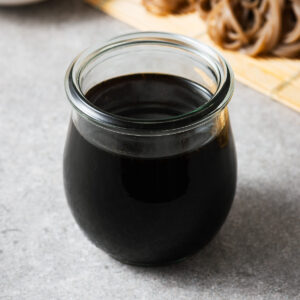
Ingredients
- ¼ cup sake
- ½ cup mirin
- ½ cup soy sauce
- 1 2-inch square kombu (dried kombu kelp)
- 1 heaped cup heaped cup katsuobushi (dried bonito flakes)
Instructions
- In a small saucepan, bring the sake to a boil over medium heat and cook for a few seconds to allow some of the alcohol to evaporate.
- Add the remaining ingredients and bring the sauce to a gentle simmer. Reduce to low heat to maintain the gentle simmer and cook for 5 minutes.
- Remove the saucepan from the heat and allow the mentsuyu sauce to cool down for at least 5 minutes – you can leave it for longer if you have more time.
- Drain the liquid through a fine mesh strainer to remove the kombu and katsuobushi.
- Your mentsuyu is ready to use. To store the mentsuyu, transfer it to a clean jar or airtight container and refrigerate for up to 4 weeks.
Notes
- For vegan mentsuyu: Swap the katsuobushi for rehydrated dried shiitake mushrooms. Rinse 3 dried shiitake mushrooms to remove any grit. Then place them in a bowl and cover with water. Leave the mushrooms to rehydrate for an hour before you start the recipe. Then follow the recipe using the rehydrated mushrooms instead of katsuobushi.
- For the quickest mentsuyu: Substitute the kombu kelp and katsuobushi with a teaspoon of dashi powder and mix to combine. There is no need to simmer or strain.
- Mentsuyu is a concentrated soup base that you need to dilute before using. For a cold dipping sauce, start with 1 part mentsuyu to 2 parts cold water. And for a warm noodle soup base, start with 1 part mentsuyu to 3 parts hot water. Taste and adjust the ratio of water to mentsuyu sauce.
- Keep the spent kombu and katsuobushi in an airtight container and store it in the refrigerator for a week or in the freezer for up to a month. Use it to make furikake seasoning (recipe from Just One Cookbook). Or finely chop the katsuobushi and kombu, then mix it with a splash of toasted sesame oil, toasted sesame seeds and a sprinkle of togarashi (or chilli flakes). Generously spoon this condiment over rice and noodle dishes for an instant flavour boost!
Try more Japanese sauce recipes
- Sukiyaki sauce (for hot pots)
- Goma dare (sesame sauce)
- Okonomiyaki sauce (for cabbage pancakes)
- Yakisoba sauce (Japanese noodle sauce)
- All-purpose miso sauce

This soup base was so good. Will definitely make it again.
I’m so glad you loved it, Paula!
The Mentsuyu recipe is excellent! It’s flavorful, versatile, and easy to make. Perfect for adding a delicious touch to various dishes. Thank you for sharing this wonderful recipe!
I’m so happy you loved it as much as I do, Heather!